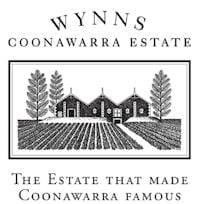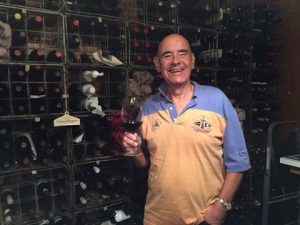In celebration of Wynnsday celebrated on the first Wednesday each year in August, enjoy a six part series tracing the history, the eras and tasting notes on Wynns Coonawarra flagship Black Label Cabernet Sauvignon.
PART ONE
I enjoyed a great article in Wine Spectator magazine about Wynns Coonawarra and agree with them that Wynn’s is without question the most important winery in Coonawarra. While the John Riddoch Cabernet and Michael Shiraz are supposedly its prestige release, I believe it is its Black Label Coonawarra Cabernet Sauvignon that is its most recognised and most loved wine in Australia.
It’s always excellent value, and there can hardly be a serious cellar in Australia without a few vintages tucked away. It was first made in 1954 and last year saw the 60th release with the 2015 vintage. To celebrate the occasion, Wynns held an extraordinary tasting, showing every Black Label ever made — all 60! They had done a similar exercise to celebrate 50 vintages in 2004. We will look at that in parts 4, 5 and 6 of this special series.

But first, in this part lets look at the history of the region itself.
Coonawarra itself consists some 5,700 ha (14,000 acres). It sits on a long, thin, very, very flat cigar-shaped piece of rich red terra rossa soil. It is one of the very few wine regions on the world that is not, specifically a tourist destination. You go to Coonawarra to taste the wines. It is also cold (or “cool to moderate”). The climate is actually quite similar to that of Bordeaux – just a little warmer and with less rain during the growing season.
It is the terra rossa soil that has made the region famous. The strip, a little under 30 km long and 2 km wide, is ideally suited to Cabernet. The soil sits on a bed of porous limestone, which assists with winter drainage and summer moisture retention. Located in the very southeastern part of South Australia, it is nearly equal distance between Melbourne and Adelaide.
In 1852, a young Scot named John Riddoch traveled to the goldfields of Victoria. He soon realised that there was far more money to be made in providing goods and services to the miners. Within a decade, he had left the goldfields with his profits and purchased a large sheep property near Penola in South Australia, called Yallum Estate.
Wool prices in America were booming, but Riddoch had always believed his property was suitable for more than sheep. In 1890 he formed the Penola Fruit Company. The following year, Riddoch had 400 ha (1000 acres) of the property surveyed into blocks of between 10 ha and 50 ha (25-125 acres) and he planted his first vines. He planted mostly Shiraz with some Cabernet. He later added a little Malbec and some Pinot Noir.

1895 saw the first Coonawarra vintage, just over 8,000 litres. Riddoch wanted to make a statement with his winery, so in 1897 he had built what has become one of the most iconic sights in Australia – the unmistakable treble-gabled limestone cellars that have since adorned the label of many hundreds of thousands Wynns labels and still stand proudly as a symbol of the region. (see left).
At the time, they were intended to hold around 350,000 litres. Bizarrely, the vines in front of them were not Cabernet; they are not even red. Rather, they were Pedro Ximenez, planted in 1917, an era when table wines had fallen out of favour. Vintage in 1897 was around 90,000 litres.
Riddoch suggested the town change its name to Coonawarra, and the company did as well, becoming Coonawarra Fruit and Vine Growers’ Association. Things were going well, and the leading local wine-growing magazine of the day reported that “Coonawarra claret is now being drunk throughout the district and it has ousted other brands.” Sample consignments were sent to the UK. The following year, Riddoch employed a full-time winemaker, Ewen McBain, who had graduated from Roseworthy College, established in 1883.
The tide turned a few years later. Riddoch passed away in 1901. Federation meant the removal of trade barriers between the colonies, now states. Other regions, better known and long established were more competitive. Coonawarra’s isolation has always been a problem when trying to attract workers and it was even worse back then. The one positive for the region was that in 1901, a 14 year-old boy named Bill Redman started working at the winery.
Various wars did not help Coonawarra’s labour plight. Desperate for a solution, Riddoch’s executors did the only thing they could: they turned the extensive stock of fine but ultimately unsalable wine into brandy. The distillery’s chimney still stands next to the winery today.
Chateau Tanunda, from the Barossa Valley, purchased the place to continue the distillation. They, in turn, were taken over in 1921 by Milne & Co. Until the mid-1940’s, almost all the grapes went to distillation, but not before a grape glut in the 1930’s led to a scheme whereby the government offered growers a subsidy to rip up their vines and convert their property into dairy farms. By the end of the decade, only 240 ha (600 acres) of vines remained.
One winery from the region was attempting to hold the fort during this period —Woodley’s St Adele Claret— which was enjoyed both domestically and overseas, but a valiant search of the label would have told the drinkers of the day nothing at all about its origins. Coonawarra was not mentioned. Woodley’s played an important role in the region’s revival, much more so than most wine lovers might realise, for it was a man from Woodley’s who was to turn around the fortunes of Wynns and Coonawarra as a whole.
Tony Nelson, an Austrian-trained winemaker (his name having been anglicised), worked at Woodley’s winery in the foothills of the Adelaide Hills from 1940. In 1946, for 9000 pounds he purchased the old Riddoch winery and accompanying 55 ha (136 acres) or more and renamed them Chateau Comaum.
The Redmans continued to work their own vineyards and winery but also assisted Nelson, producing the only table made wine in Coonawarra – Redman’s Shiraz, mostly purchased in bulk by Woodley’s. Finally, in 1951, they left to concentrate on their own wines (at the neatly names Rouge Homme winery), and Nelson was forced to put the property back on the market.
And so, in 1951, for the price of 22,000 pounds, the Melbourne-based wine merchant S.Wynn & Co purchased the old winery, cellars, distillery, 54 ha (133 acres) of vines, and 90 ha (222 acres) of pasture. Australian wine would be forever changed. At this time, Wynnes Coonawarra Estate (the first Australian winery to use the term “estate”), as it became known, was the only winery in the region other than the small operation at Rouge Homme.
In part two of this series lets look at the early history of Wynns Coonawarra Estate

